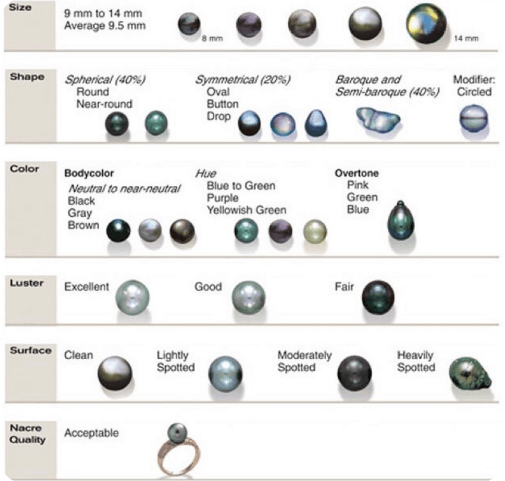Pearl Guide
Kendra Wollert GG CG • January 15, 2021
7 Pearl Values Guide to Purchasing
How a pearl is created
Cultured Pearl Products
Akoya-Usually cultivated in China and Japan, the typical size ranges from 6 mm – 7 mm, but other sizes do exist. The body color is usually white to cream but other natural colors exist, including gray, blue, and yellow.
South Sea-Ranging in color from white to golden, yet other colors can be attained, and sizes include 8 mm to 15 mm. The principal commercial farming areas are in the Philippines, Australia, and Indonesia.
Tahitian-Cultivated primarily around the islands of French Polynesia, these pearls range in color from white to black to other colors including green and purple. The spectrum of sizes is 8 mm to 14 mm, although larger sizes do exist in limited quantities.
Freshwater-This type of pearl has the most variety of sizes, shapes, and colors. While Japan and the United States produce small quantities, most freshwater pearls are sourced from China.
Keshi-Irregularly shaped pearls that come in a wide range of size and colors. Keshi means “poppyseed” in Japanese.
Blister-Blister pearls grow attached to the mollusk’s shell. One side is flat and nacre-free and can be from freshwater or saltwater mollusks.
Seven Value Factors
These seven factors help jewelers determine a fair price for the product. **Please note the images found at the end of this article, for quality visualization.
1. Size-Measured in millimeters (mm); Measure diameter for round pearls and length and width for other shapes. For multiple pearls in a product, a range is given (7 – 7.5 mm).
2. Shape-Seven standard shapes fit into three categories:
4. Luster-four categories represent luster, the intensity of light reflected from the pearl’s surface. Note the crispness of light above the pearl reflected on the pearl surface.
Care and Cleaning
Pearls, whether natural or cultured, are made inside a mollusk. Mollusks can be oyster or mussels and must be the type that builds a mother-of-pearl lining on the inside of the shell. If they can build mother-of-pearl, they have the ability to create nacre, the semi-hard outside layers of a pearl. Natural pearls form when a parasite or another foreign matter irritates the mollusk to secrete layers of nacre to smooth over the irritant. The majority of pearls on the market are cultured pearls. Two types of cultured pearls exist, saltwater and freshwater. Cultured saltwater pearls have humans that insert a bead nucleus and a piece of mantle tissue into the mollusk. “The mantle is an organ within a pearl-producing mollusk that manufactures both conchiolin and calcium carbonate-the essential building blocks of both the mollusk’s shell and pearls (GIA, 2000; Pearl Grading: Pearl description system manual, p. 2).” Freshwater cultured pearls have only a piece of mantle tissue inserted into the mussel that irritates the mollusk to produce the layering nacre.
Akoya-Usually cultivated in China and Japan, the typical size ranges from 6 mm – 7 mm, but other sizes do exist. The body color is usually white to cream but other natural colors exist, including gray, blue, and yellow.
South Sea-Ranging in color from white to golden, yet other colors can be attained, and sizes include 8 mm to 15 mm. The principal commercial farming areas are in the Philippines, Australia, and Indonesia.
Tahitian-Cultivated primarily around the islands of French Polynesia, these pearls range in color from white to black to other colors including green and purple. The spectrum of sizes is 8 mm to 14 mm, although larger sizes do exist in limited quantities.
Freshwater-This type of pearl has the most variety of sizes, shapes, and colors. While Japan and the United States produce small quantities, most freshwater pearls are sourced from China.
Keshi-Irregularly shaped pearls that come in a wide range of size and colors. Keshi means “poppyseed” in Japanese.
Blister-Blister pearls grow attached to the mollusk’s shell. One side is flat and nacre-free and can be from freshwater or saltwater mollusks.
Mabe-These pearls are cultured blister pearls that have been cut from the shell and the nucleus has been removed. The resulting void then has a backing of mother-of-pearl epoxied to the area.
These seven factors help jewelers determine a fair price for the product. **Please note the images found at the end of this article, for quality visualization.
1. Size-Measured in millimeters (mm); Measure diameter for round pearls and length and width for other shapes. For multiple pearls in a product, a range is given (7 – 7.5 mm).
2. Shape-Seven standard shapes fit into three categories:
Spherical
Round-appears round to the eye. For a strand, roll the pearls on a pad under your fingers and watch the outline for pearls that break the plane.
Near-round-appears almost round to the eye.
Symmetrical
Oval-symmetrical, rounded, oblong shape.
Button-symmetrical, flattened, or slightly flattened, circular shape. Can be a high button or a low button.
Drop-symmetrical, rounded, pear-shape. Can be a long drop or a short drop.
Baroque
Semi-baroque-non-symmetrical, off-round, slightly irregular oval, button, or drop shape.
Baroque-non-symmetrical shape-will have a noticeably irregular appearance.
For any other shape that does not fit into these shape categories, describe the shape as it appears: coin, bar, cross, for example. 3. Color-three components of color exist, bodycolor, overtone, and orient. Bodycolor
is the overall color of the pearl. Overtone
is the noticeable translucent color found over the bodycolor. Orient
is the iridescence found on or just below the surface. Not all pearls display all three characteristics.
4. Luster-four categories represent luster, the intensity of light reflected from the pearl’s surface. Note the crispness of light above the pearl reflected on the pearl surface.
Excellent-reflections are bright, sharp, and distinct.
Good-reflections are bright but not sharp. They are slightly hazy around the edges.
Fair-reflections are weak, hazy, and blurred.
Poor-reflections are dim and diffused.
5. Surface quality (blemishes)-“Most pearls have surface characteristics, or irregularies. Surface condition is judged by the size, number, location, visibility, and type of blemishes. Blemishes affect the pearl’s appearance while some affect both appearance and durability. Few pearls are completely blemish-free (GIA, 2000; Pearl Grading: Pearl description system manual, p.6).” When viewing, consider the size, number, location, visibility, and types of blemishes. Four ratings exist for surface quality:
Clean-blemish-free or minute surface characteristics difficult to the trained eye.
Lightly blemished-minor surface irregularities to the trained eye.
Moderately blemished-noticeable surface characteristics; a few might be quite noticeable.
Heavily blemished-obvious surface irregularities; durability might be affected.
6. Nacre quality-determined by its thickness and layering. If the nucleus is visible, the nacre is too thin. A chalky appearance might indicate thin nacre or poor nacre layering. Three quality classifications exist:
Acceptable-nucleus not noticeable; no chalky appearance.
Nucleus visible-the bead nucleus is evident through the nacre; pearls show blinking when rotated.
Chalky appearance-pearls have an obvious dull appearance.
7. Matching-describes the uniformity of pearls in jewelry. The six other value factors need to be consistent throughout the jewelry piece. Matching does not impact single pearls.
Treatments
Bleaching-an extremely common treatment to white pearls; bleaching is a way to clean and brighten the pearl surface and it lends a more uniform look to matched pearls.
Dyeing-alters the basic pearl color.
Irradiation-permanently alters the pearl’s color.
Coating-enhances the luster of pearls and are usually used on lower quality goods. The effect might not be permanent.
Care and Cleaning
Consult the How To Clean Pearls video at https://www.olufsondesigns.com/how-to-clean-pearls
References
GIA, 2000; Pearl Grading: Pearl description system manual. GIA, 1999; Pearls: Value Factors
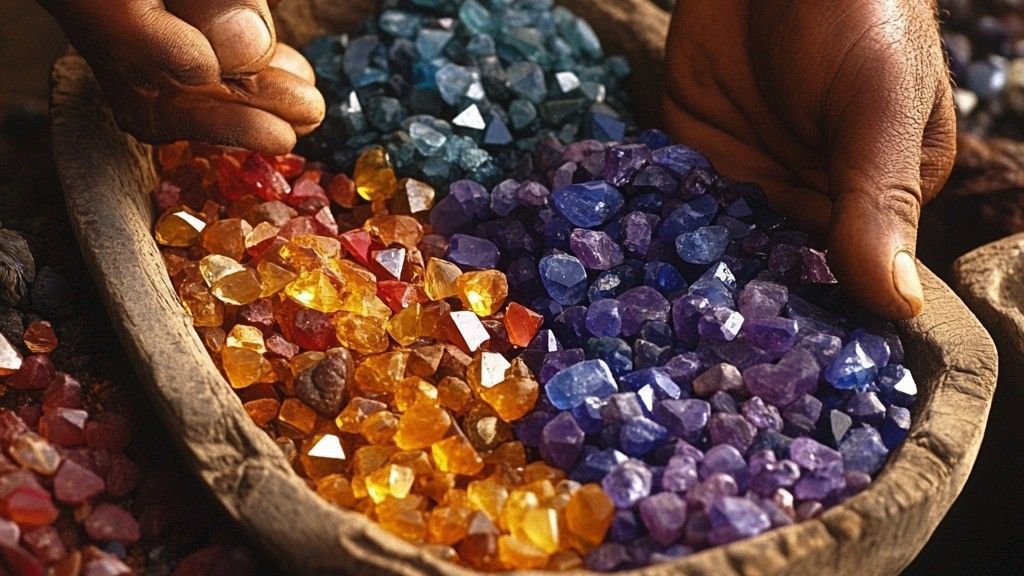
As Elisa heads off to Sri Lanka to do another deep dive into the colored gemstone supply chain, it has us reflecting on what makes our work so wonderful. The beauty of colored gems invokes so many emotions — joy, wonder, love, and sometimes even awe at what nature creates. Each gemstone has a story that begins long before it reaches our studio in Corvallis — a story of people, place, and purpose. At Olufson Designs, we believe that jewelry should shine from the inside out. That means sourcing gemstones with care, respect, and integrity — honoring the journey from mine to market and the communities who make it possible. Across the world, much of the colored gemstone trade begins in small, artisanal mines. These are often family operations — hand tools instead of heavy machinery, generations of knowledge instead of industrial systems. While these miners work with modest means, they are the heartbeat of the global gem trade. Supporting them responsibly can create a ripple of good far beyond the sparkle of a finished gem. Gem Legacy is one of the organizations helping make that happen. Founded by members of the gem and jewelry industry, Gem Legacy supports East African mining communities with direct, grassroots projects — providing equipment for miners, scholarships for gem-cutting students, and infrastructure improvements that change daily life. In Tanzania and Kenya, their work has helped fund vocational training for local gem cutters, supply mining safety gear, and build a children’s home near one of the mining areas. These aren’t distant, top-down initiatives — they’re tangible acts of empowerment led by people who know and love the gem world. Closer to home, Columbia Gem House has built its entire business model around the idea of Fair-Trade Gems® . From their base in the Pacific Northwest, they’ve partnered directly with miners for decades, developing transparent relationships that ensure fair wages, safe working conditions, and environmentally responsible practices. They pay above-market prices for rough material, helping miners reinvest in their communities, and they maintain a strict cutting and polishing code to ensure every step of the journey honors people and planet alike. For Columbia Gem House, traceability isn’t a buzzword — it’s a promise. These efforts — from Gem Legacy’s scholarships to Columbia Gem House’s long-term partnerships — reflect a growing movement within the jewelry world to do better. They remind us that beauty and ethics can coexist beautifully when compassion and transparency guide the process. At Olufson Designs , that’s the spirit we embrace when selecting the gemstones we work with. Whether a sapphire from Montana, a garnet from East Africa, or an opal from Oregon, we look for sources that uplift communities, preserve environments, and ensure that every stone has a positive legacy. When you wear one of our pieces, you’re not just wearing color and sparkle. You’re wearing a story of human connection — the miner who unearthed the gem, the cutter who revealed its brilliance, the designer who envisioned its setting, and you, who give it meaning by making it part of your life. Because the best gems don’t just come from the earth. They come from the heart. Top Image: Stoner Eron, via LinkedIn (original article “Trade to Treasure: How Gemstones Shaped Global Commerce,” 2024).
As the leaves turn and the air grows crisp, a beautiful trend continues to flourish: Fall weddings. More couples are choosing September through November to say “I do,” celebrating with rich color, cozy textures, and an atmosphere of warmth and elegance. Below, we explore the most popular fall-wedding styles for 2025 — and how Olufson Designs can help with jewelry to make your day (or attendance) unforgettable. Why Fall? Fall provides a naturally romantic backdrop: golden light, softened landscapes, and a palette of rust, amber, burgundy, and sage. These hues lend themselves beautifully to wedding décor, floral installations, and statement accents. Couples are embracing cozy, immersive experiences — fire pits, lounge zones, layered textures, and warm lighting that wraps guests in intimacy. Fashion and jewelry trends also align with the season: warm metals, colored gemstones, and mixed textures complement autumn’s rich tones beautifully. The Magic of a Pacific Northwest Fall For those celebrating in the Pacific Northwest, the season offers a backdrop unlike anywhere else. Towering evergreens, misty mornings, and vibrant autumn leaves paint landscapes in amber, rust, and gold. Vineyards, forest venues, and riverside escapes provide unforgettable settings for ceremonies and photos. Jewelry reflecting nature’s colors — warm golds, amber gemstones, forest greens and rich reds — perfectly enhances this seasonal palette. Four Popular Fall Wedding Styles 1. Rustic-Chic Barn / Farm Wedding Rustic farm weddings combine wood, dried florals, and vintage accents. Jewelry tip: Brushed gold, oxidized silver, or delicate nature-inspired pieces complement the setting elegantly. 2. Moody Glam / Dark & Dramatic Deep jewel tones, luxe fabrics, and moody palettes create drama and sophistication. Jewelry tip: Bold gemstone pieces, blackened silver, or mixed metal stacks anchor the look beautifully. 3. Garden / Woodland Romantic Outdoor settings with wild florals, asymmetrical arrangements, and natural texture are on trend. Jewelry tip: Organic pieces like vine or leaf motifs, or clustered gemstones, enhance the ethereal feel. 4. Modern Minimalist / Elevated Neutrals Serene palettes, clean lines, and subtle layering appeal to minimalist tastes. Jewelry tip: Sleek studs, fine chains, or slim bracelets highlight craftsmanship and finish. How Olufson Designs Can Help At Olufson Designs we’re passionate about creating jewelry that complements the season, the style, and the story. Bridal & Engagement Jewelry: Timeless or custom rings, necklaces, and bracelets. Wedding Party & Guest Gifts: Pieces your friends and family will treasure. Seasonal Collections & Styling Advice: Warm metals, gemstone accents, and on-trend designs. Custom & Bespoke Work: Floral motifs, heirloom remakes, and one-of-a-kind creations. Autumn weddings reflect warmth, transformation, and deep romance. Whether planning your own wedding or attending as a guest, the right jewelry elevates every moment. Let Olufson Designs add that finishing sparkle to your special day. Sources 1. Archer & Bliss. The Ultimate Guide to Fall Wedding Trends. archernbliss.com 2. Teach Jewelry. How to Choose Statement Jewelry for Fall Weddings. teachjewelry.com 3. Junebug Weddings. 10 Delightfully Cozy Fall Wedding Ideas. junebugweddings.com 4. The Crescent Beach Club. The 5 Biggest Fall Wedding Trends. thecrescentbeachclub.com 5. Brides magazine. “21 Fall Wedding Décor Ideas for a Gorgeous Seasonal Celebration” (Sept 4, 2025). brides.com 6. PNW Wonderful Weddings. Fall Wedding Ideas. pnwonderfulweddings.com 7. Photography: https://ronnyandrene.com/
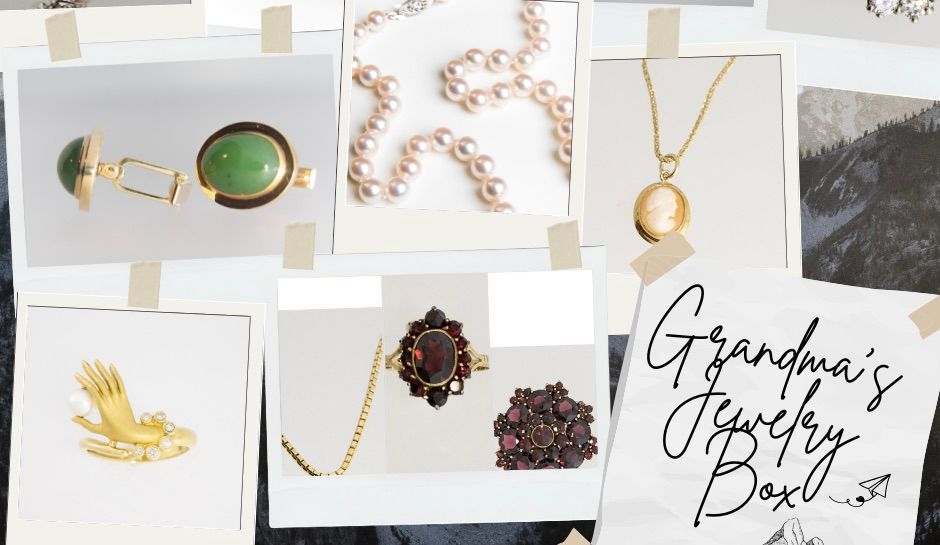
In the coming years, we are living through what financial experts are calling The Great Wealth Transfer. An estimated $84 trillion will move from one generation to the next in the United States over the next two decades, as Baby Boomers and older generations pass along their assets to children and grandchildren. Among the stocks, properties, and savings accounts, one of the most meaningful forms of inherited wealth is often overlooked: jewelry. Unlike other assets, jewelry tells a story. It carries the warmth of family gatherings, the sparkle of milestone celebrations, and the quiet strength of loved ones who came before us. A grandmother’s engagement ring, a father’s cufflinks, or a string of pearls tucked away for decades—these aren’t just valuables, they’re living connections. At Olufson Designs, we understand the unique role jewelry plays in this generational transfer of wealth. As families inherit heirloom pieces, they often face questions: • What should we do with jewelry we may not wear? • How can we honor its history while making it part of our lives today? • Is there a way to update or repurpose jewelry without losing its sentimental value? That’s where we come in. Redesigning with Respect One of our specialties at Olufson Designs is reimagining heirloom jewelry. Perhaps your mother’s diamond ring doesn’t fit your lifestyle, or an inherited brooch sits unworn in a drawer. Our designers work with you to create something that reflects your style while preserving the legacy. A brooch can become a pendant, loose diamonds can be reset into modern earrings, and an outdated setting can be transformed into a piece you’ll treasure every day. Repairing and Restoring Time takes its toll, even on the finest jewelry. Clasps weaken, prongs bend, and stones loosen. Before wearing inherited jewelry, it’s important to make sure it’s secure. Our team of associates and jewelers carefully inspect and restore pieces so they can be worn safely without losing their original charm. Sometimes, the most meaningful gift we give is simply bringing a family treasure back to life. Appraisals and Guidance Inherited jewelry also comes with practical questions. What is it worth? Should it be insured? Is it best to keep, sell, or repurpose? Olufson Designs offers professional appraisals and honest guidance. Whether you want to understand the value for estate purposes, decide which pieces to keep, or explore options for selling or trading , we can help you make informed choices. Keeping the Story Alive The Great Wealth Transfer is about more than money—it’s about memories, traditions, and meaning. Jewelry has the rare ability to embody all three. By caring for, redesigning, or restoring inherited pieces, you ensure that your family’s story continues in a way that feels authentic to you. At Olufson Designs, we see it as an honor to help families during this once-in-a-generation shift. When the jewelry box passes from one set of hands to the next, we’re here to make sure those treasures remain just that—treasured. Stop by our Corvallis store or reach out to schedule a consultation. Let’s discover how your inherited jewelry can carry its history into your future.
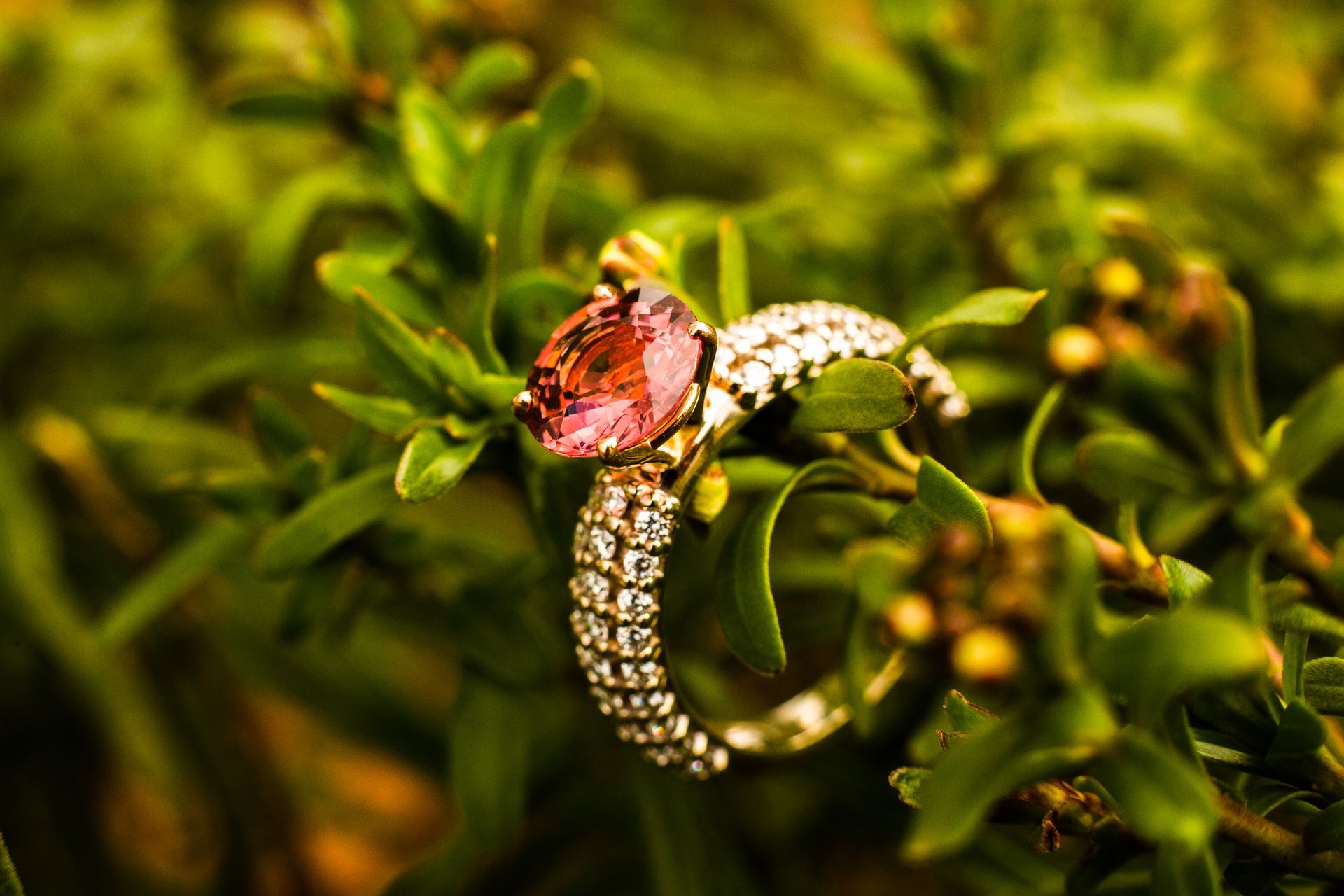
The traditional August birthstones are peridot and sardonyx but in 2016 the American Gem Trade Association (AGTA) and Jewelers of America (JA) made the decision to include spinel. Spinel is a gemstone that has been historically mistaken for ruby (mineral: corundum). It wasn’t until a few hundred years ago that minerologists were able to make the distinction. While the red color of both ruby and spinel look very much the same, they are different minerals. Spinels are often overlooked. They are beautiful, durable, and come in a variety of colors, but are best known for their reds, pinks, purples, and rare vivid blues-colored by cobalt. Spinel is a favorite of the staff at Olufson Designs, as well as the collectors who shop with us. Spinel: A Gemstone Worth Discovering For centuries, spinel was often mistaken for other valuable stones. Many famous "rubies" in royal collections, including the legendary 170 carat Black Prince's Ruby in the British Crown Jewels, the 352 carat Timur Ruby, and the 398 carat Catherine the Great’s Ruby (all historically misidentified), were later identified as magnificent spinels. This historical case of mistaken identity only adds to its intriguing story, highlighting just how closely its beauty can rival its more famous cousin. So, what makes spinel such a compelling gemstone? A Spectrum of Sensation: One of spinel's most captivating features is its incredible color range. While red spinels are particularly prized and can closely mimic the vibrant hues of rubies, you'll also find them in breathtaking shades of pink, orange, purple, blue, and even black. The blues can range from a delicate periwinkle to a deep, inky sapphire-like tone, often with a subtle grayish modifier that gives them a unique allure. Greens are rarer, and some spinels even exhibit a mesmerizing color change phenomenon under different lighting conditions. This vast palette means there's a spinel to suit every taste and style. Brilliance and Durability: Beyond its captivating colors, spinel possesses excellent optical properties. It has a high refractive index, meaning it sparkles with an impressive fire and brilliance. On the Mohs scale of hardness, spinel scores an 8, making it a very durable gemstone suitable for everyday wear. This makes it a fantastic choice for engagement rings, pendants, earrings, and any piece of jewelry destined to be cherished for years to come. An Ethical Choice: For those concerned about ethical sourcing, spinel offers another compelling advantage. It's found in various locations around the world, including Myanmar (Burma), Sri Lanka, Tanzania, Vietnam, and Pakistan. Its diverse origins often make it easier to source spinels responsibly, providing a more transparent supply chain for conscious consumers. A Smart Investment: While high-quality red and cobalt blue spinels can command significant prices, many other colors of spinel are still relatively affordable compared to their ruby or sapphire counterparts of similar quality. This makes spinel an excellent option for those seeking a beautiful and durable gemstone often without the premium price tag. As awareness of spinel's beauty and value continues to grow, it's increasingly being recognized as a savvy choice in the world of gemstones. Next time you're considering a new piece of jewelry, don't overlook the magnificent spinel. Its rich history, stunning variety of colors, impressive brilliance, and excellent durability make it a truly exceptional gemstone, deserving of its moment in the spotlight. Discover the understated elegance of spinel and add a touch of unique sparkle to your collection.
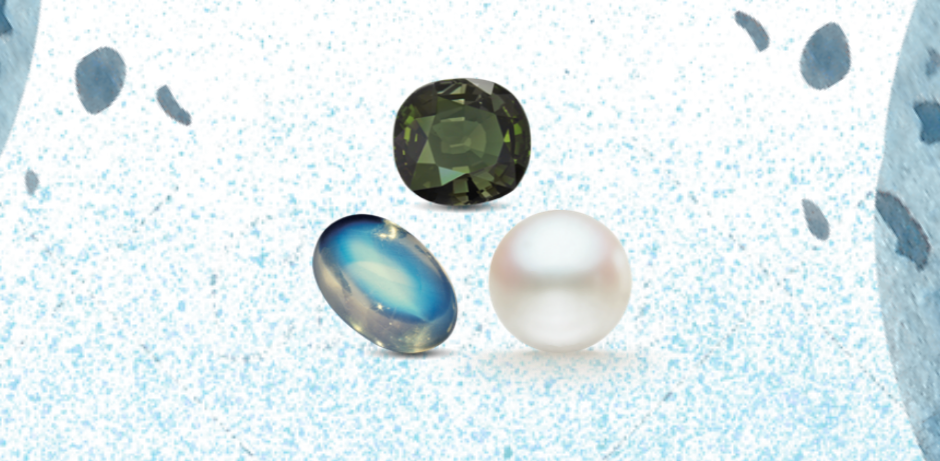
June is a month of change and celebration—school years end, graduates step into new life chapters, and families honor fathers and father figures. Those born in June are lucky to have not just one, but three official birthstones: pearl, moonstone, and alexandrite, each offering unique beauty and symbolism. Pearls , the most iconic of June's stones, have long been associated with purity, wisdom, and tranquility. They are the only gemstones formed within living creatures—primarily oysters and mussels. Pearls occur naturally in the wild, but most pearls on the market today are cultured. Natural pearls are extremely rare and expensive; cultured pearls, on the other hand, are created by manually introducing an irritant into the mollusk to initiate pearl formation. Though human-assisted, cultured pearls are still grown organically and possess the same chemical and physical properties as their natural counterparts (Gemological Institute of America, 2024). Interestingly, pearls are no longer reserved for women alone. In recent years, men have increasingly embraced pearl jewelry, from subtle studs to full necklaces. Celebrities like Harry Styles, A$AP Rocky, and Pharrell Williams have helped usher pearls into the realm of modern menswear, reflecting a broader shift toward gender-fluid fashion (Vogue, 2023). Pearls now symbolize both timeless sophistication and bold, contemporary style. Moonstone , with its pearly glow of light and ties to lunar energy, represents intuition and emotional balance. It was especially popular during the Art Nouveau period (between about 1890 and 1910) and is often associated with new beginnings—fitting for graduates and anyone facing a life transition. Alexandrite , a rare and color-changing gem, shifts from green in daylight to reddish-purple in incandescent light. This optical magic symbolizes adaptability and transformation, aligning perfectly with the themes of graduation and personal growth. Its rarity and value also make it a meaningful gift for special occasions. June is also marked by Father’s Day, a time to celebrate paternal bonds and the influence of fathers and mentors. Giving a birthstone accessory—such as pearl-handled corkscrew or pearl or alexandrite studs—can be a memorable and personalized gift. With its blend of meaningful events and diverse gemstones, June is a month rich in symbolism. Whether you’re honoring a new graduate, a beloved father, or your own birthday, June’s birthstones offer timeless ways to mark life's milestones. ________________________________________ Sources: • Gemological Institute of America (GIA). “Pearl Guide.” www.gia.edu • Vogue. “The Rise of Men in Pearls: A New Wave of Jewelry.” 2023. • American Gem Society. “June Birthstones.” www.americangemsociety.org
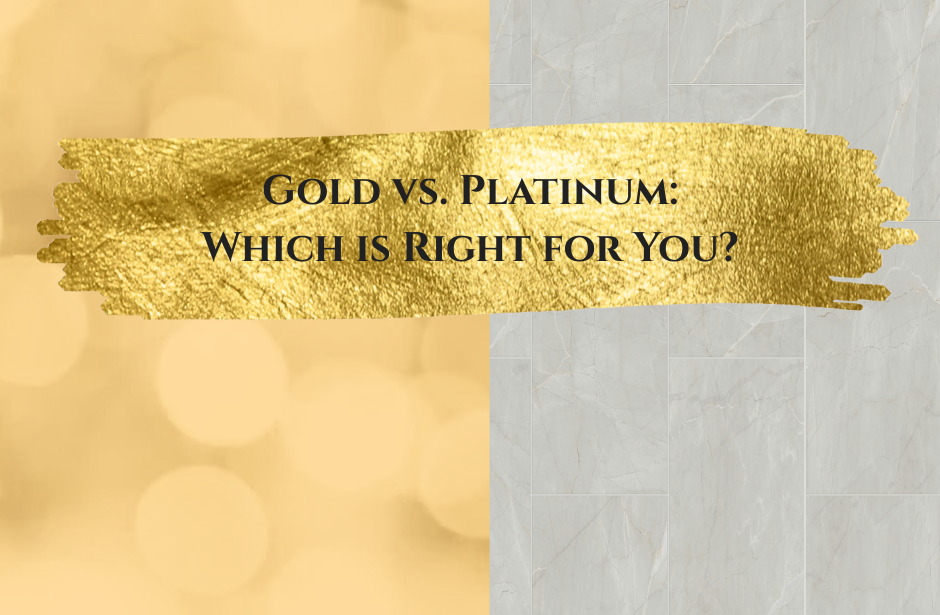
When choosing fine jewelry, especially engagement rings or wedding bands, the metal is just as important as the gemstone. Gold and platinum are the two most popular precious metals, each with distinct characteristics. Understanding the differences can help you choose the one that best suits your lifestyle, aesthetic preferences, and budget. Durability and Wear Platinum is denser and more durable than gold, making it ideal for everyday wear. It's naturally white and doesn’t need to be alloyed to maintain its color, unlike white gold, which is mixed with other metals and usually rhodium-plated to achieve a similar hue. Over time, white gold may require re-plating to maintain its brightness, while platinum develops a patina that many find elegant and timeless (Gemological Institute of America, GIA.edu). Gold, on the other hand, is softer—especially in higher purities like 18k or 22k—and more prone to scratching. However, it’s still a strong, workable metal, and the variety of gold colors (yellow, white, and rose) offers greater aesthetic flexibility (American Gem Society, americangemsociety.org). Price and Value Platinum is generally more expensive than gold. This is due to its rarity and density—platinum is about 60% heavier than gold, so the same ring in platinum will weigh (and cost) more (GIA). Additionally, platinum is mined less frequently, which adds to its cost. Gold, especially 14k or 18k, offers a more budget-friendly option without sacrificing elegance or prestige. It’s a practical choice if you're looking for beauty, tradition, and versatility at a slightly lower price point. Maintenance and Lifestyle For those with active lifestyles or those who work with their hands, platinum's strength and resistance to wear may be a better long-term investment. While sounding contradictory, platinum is quite malleable, so lifting heavy objects while wearing platinum is not advisable lest it will misshapen. However, some may prefer the lighter weight of gold for comfort. Platinum is often recommended for those with metal sensitivities due to its purity (usually 95% pure). Essentially, the purer a metal is, the more hypoallergenic it should be. Because gold is very soft at 20-24 karat, expect rings to require extra attention throughout its life if you choose this more hypoallergenic option. Most jewelers would say platinum is the better choice. The Bottom Line Choose platinum if you want a low-maintenance, highly durable, naturally white metal that stands the test of time. Opt for gold if you value traditional beauty, color variety, and affordability. Whether you're choosing a lifelong symbol of love or treating yourself to something special, understanding these differences will help you make a confident, informed choice. Sources: • Gemological Institute of America (GIA): www.gia.edu • American Gem Society (AGS): www.americangemsociety.org

Anniversaries are cherished milestones that celebrate the enduring journey of love and commitment between partners. Selecting the perfect jewelry gift can beautifully commemorate the significance of each year spent together. This guide explores meaningful jewelry options for key milestone anniversaries, blending traditional symbols with contemporary elegance. 1st Anniversary: Gold The first year of marriage lays the foundation for a lifelong partnership. Gold, symbolizing purity and prosperity, is the traditional choice for this milestone. Consider gifting a delicate gold necklace or a pair of classic gold earrings to commemorate this special occasion. 5th Anniversary: Sapphire Reaching five years together signifies strength and wisdom. Sapphires, known for their deep blue hue, represent loyalty and trust—qualities that have deepened over this period. A sapphire pendant or a ring can serve as a beautiful reminder of your shared journey. 10th Anniversary: Diamond A decade of togetherness is a testament to enduring love. Diamonds, with their unparalleled brilliance and resilience, symbolize this lasting bond. Consider a diamond bracelet or an upgraded engagement ring to celebrate this significant milestone. 15th Anniversary: Ruby Fifteen years together embodies passion and devotion. Rubies, with their vibrant red color, epitomize the deep love shared over the years. A ruby necklace or earrings can add a touch of elegance and meaning to this celebration. 20th Anniversary: Emerald Two decades together highlight growth and harmony. Emeralds, symbolizing renewal and vitality, reflect the evolving nature of your relationship. An emerald ring or pendant can beautifully mark this occasion. 25th Anniversary: Silver Jubilee Celebrating a quarter-century together is a remarkable achievement. Silver, representing clarity and strength, is traditionally associated with the 25th anniversary. A sterling silver bracelet or cufflinks can serve as a timeless token of your enduring partnership. 30th Anniversary: Pearl Thirty years of marriage reflect wisdom and beauty cultivated over time. Pearls, formed through years of refinement, symbolize this journey. A classic pearl necklace or a pair of pearl earrings can elegantly commemorate this milestone. 40th Anniversary: Ruby Revisiting the ruby at forty years underscores the ongoing passion and love that have sustained your marriage. A ruby brooch or cufflinks can be a meaningful gift, celebrating the depth of your connection. 50th Anniversary: Golden Jubilee Half a century together is a monumental milestone. Gold, denoting prosperity and strength, is the quintessential symbol for the 50th anniversary. A gold watch or a pair of gold earrings can honor this incredible journey. Personalizing Your Gift While traditional gemstones and metals provide a meaningful framework, personalizing your gift adds a unique touch. Consider incorporating birthstones, engraving significant dates or messages, or selecting designs that resonate with shared memories. For instance, Olufson Designs offers custom jewelry options that can be tailored to reflect your unique story. In conclusion, selecting anniversary jewelry that aligns with traditional symbols while incorporating personal touches can create a heartfelt tribute to your shared journey. Whether adhering to classic choices or exploring contemporary designs, the thoughtfulness behind the gift will undoubtedly make your celebration memorable. Sources https://www.withclarity.com/blogs/jewelry/the-ultimate-jewelry-gift-guide-for-birthdays-anniversaries?srsltid=AfmBOorpXyiycYQ_1uxFIxp2pm2eziWa5YZudkT4qr89I1gb0R-57Kr5&utm https://www.brides.com/upgrading-engagement-wedding-rings-anniversary-8743637?utm https://www.gemsociety.org/article/anniversary-jewelry-gift-guide/?utm https://faithfulplatform.com/blog/ultimate-anniversary-gift-guide-for-fine-jewelry?utm https://blog.brilliance.com/diamonds/best-anniversary-jewelry-gift-ideas-for-every-milestone?utm https://www.inspereza.com/blogs/inspiration/the-ultimate-guide-to-anniversary-jewelry-gifts?srsltid=AfmBOoousdXp2N1D8c-_lwt1XiwGpSaeA-z28YVAHxdx_g-guaSJhbgR&utm
Mixing metals in jewelry is a stylish way to create a unique and versatile look. After about 25 years of white gold being very popular, we are in the process of transitioning to yellow gold as a preference. Generation Zs are getting married and their preference is primarily yellow. If you are the type to run with fashion, you will want to start transitioning now and slowly build your jewelry wardrobe. Transitioning from white to yellow means mixing your metals as you build your wardrobe. Whether you're layering necklaces, stacking rings, or combining bracelets, blending different metal tones can elevate your style. However, it requires a strategic approach to avoid a mismatched or chaotic appearance. Here are some essential do’s and don’ts when mixing gold, silver, and other metals in jewelry. Do: Choose a Dominant Metal Start by selecting a primary metal that will anchor your look. This should make up most of your jewelry to create a cohesive foundation. For example, if yellow gold is your base metal, you can accent it with white gold or silver pieces to add contrast without overwhelming the look. Do: Limit the Number of Metals While mixing metals adds visual interest, too many different tones can make your jewelry feel disorganized. Stick to two or three metals at most to maintain a balanced and intentional style. A classic combination is gold and silver, but adding a touch of rose gold can bring warmth and variety. Do: Consider Undertones and Skin Tone Metals have warm or cool undertones that can affect how they complement your skin tone. Yellow and rose gold have warm hues, making them ideal for warmer skin tones, while silver, platinum, and white gold have cool undertones that suit cooler complexions. Mixing warm and cool metals can be done stylishly but be mindful of how they interact with your skin tone. Do: Balance Metal Placement To ensure a harmonious look, distribute different metal tones evenly throughout your jewelry. For example, some people are lucky enough to have a two tone watch they wear every day. Having this staple is the easiest way to tie your look together. Avoid wearing all gold on one hand and all silver on the other, as this can create an unbalanced appearance. Don’t: Ignore Finishes and Textures Mixing polished, matte, hammered, or brushed finishes adds depth and interest to your jewelry. If you're wearing a high-shine silver bracelet, pair it with a brushed gold ring to create contrast. A variety of textures can make mixed-metal jewelry feel intentional rather than random. Don’t: Be Afraid to Experiment Traditional jewelry rules suggest sticking to one metal, but modern styling embraces versatility. Try layering necklaces in different metal tones or stacking rings with alternating gold and silver bands. Just ensure that the pieces share a common design element, such as similar shapes or stone settings, to maintain a cohesive feel. Don’t: Overlook Personal Style Ultimately, your jewelry should reflect your personal taste. While guidelines help create a polished look, feel free to mix metals in a way that suits your style and comfort level. Whether you prefer a delicate mix or bold contrast, confidence is key to pulling off a mixed-metal look. By following these do’s and don’ts, you can master the art of mixing metals in jewelry, creating stylish and elegant combinations that enhance your overall look. Sources https://www.jewelersmutual.com/the-jewelry-box/mixing-metal-jewelry https://www.masterclass.com/articles/how-to-mix-metal-jewelry https://www.thecut.com/article/how-to-mix-metal-jewelry-according-to-pros.
As we step into 2025, the world of fine jewelry is embracing a harmonious blend of timeless elegance and contemporary innovation. This year's trends reflect a desire for personal expression, sustainability, and a nod to both nature and technology. Here's an in-depth look at the top fine jewelry trends for 2025: 1. Bold Gold Statements Gold jewelry is making a powerful comeback with bold, voluminous designs. Think wide cuffs, chunky rings, and substantial hoop earrings that exude confidence and luxury. High-karat gold pieces with matte or textured finishes add depth and modernity to these statement accessories. These pieces are versatile, effortlessly transitioning from casual daywear to elegant evening attire. 2. Re-imagined Pearls Pearls are shedding their traditional image and are being reinterpreted in contemporary designs. Modern baroque pearls, with their unique and irregular shapes, are particularly popular, offering a fresh and edgy twist to classic pearl jewelry. Designers are incorporating pearls into asymmetrical earrings, layered necklaces, and mixed-material pieces, making them a must-have for the modern jewelry enthusiast. 3. Personalized and Zodiac Jewelry Jewelry that tells a personal story continues to captivate wearers. Initials, birthstones, and zodiac symbols are being artfully integrated into fine jewelry pieces, allowing individuals to express their identity and personal milestones. These personalized elements add a sentimental value, making each piece unique to the wearer. 4. Celestial Motifs Drawing inspiration from the cosmos, celestial-themed jewelry featuring stars, moons, and planetary symbols is on the rise. These designs evoke a sense of wonder and mystique, often embellished with diamonds and gemstones to add a sparkling allure. Celestial jewelry pieces serve as a reminder of the universe's beauty and our place within it. 5. Botanical Inspirations Nature continues to influence jewelry design, with botanical motifs gaining prominence. Intricate designs featuring leaves, flowers, and vines are crafted with meticulous attention to detail, often adorned with colorful gemstones to mimic the vibrancy of nature. These pieces celebrate the organic beauty of the natural world, bringing a touch of the outdoors into fine jewelry collections. 6. Colorful Gemstones Vibrant gemstones are taking center stage, adding a pop of color to fine jewelry. Sapphires, emeralds, rubies, opal and lesser-known stones like tourmaline and spinel are being used to create eye-catching pieces. These colorful gems are often set in minimalist designs, allowing the stones' natural beauty to shine and making them versatile additions to any jewelry collection. 7. Chain Links and Layering Chain link jewelry is evolving with innovative designs and layering techniques. From delicate, elongated links, like the paperclip chain, to bold, over sized chains, these pieces add texture and dimension to any ensemble. Layering multiple chain necklaces or bracelets of varying lengths and styles creates a personalized and dynamic look, allowing for versatility and creativity in styling. 8. Bezel Settings Bezel-set jewelry, where gemstones are encircled by a metal rim, is gaining popularity for its sleek and modern aesthetic. This setting not only offers a contemporary look but also provides enhanced protection for the gemstone, making it ideal for daily wear. Bezel settings are being used in rings, necklaces, and earrings, often showcasing solitaire diamonds or vibrant gemstones. 9. Vintage Revival Vintage-inspired jewelry is experiencing resurgence with designs that pay homage to past eras while incorporating modern elements. Art Deco motifs, intricate filigree work, and antique finishes are being reimagined in contemporary pieces. This trend allows for a nostalgic yet fresh approach to fine jewelry, appealing to those who appreciate the charm of bygone times. In conclusion, 2025's fine jewelry trends offer a diverse array of styles that cater to various tastes and values. Whether you're drawn to bold statements, personalized pieces, or sustainable choices, this year's trends provide ample opportunities to express individuality and sophistication through jewelry. Here at Olufson Designs, we have something to fit every one of these trends and in a variety of price points. Sources https://www.brilliantearth.com/jewelry/buying-guide/trends/?utm_source=chatgpt.com https://www.gabrielny.com/blog/jewelry-trends-2025/?srsltid=AfmBOorUC1KrK0-md68l6doHSyHNYXKl55ZxM0OMbgP6yywRsymbay8z&utm_source=chatgpt.com https://www.veranda.com/luxury-lifestyle/luxury-fashion-jewelry/a63247691/spring-jewelry-trends-2025/?utm_source=chatgpt.com
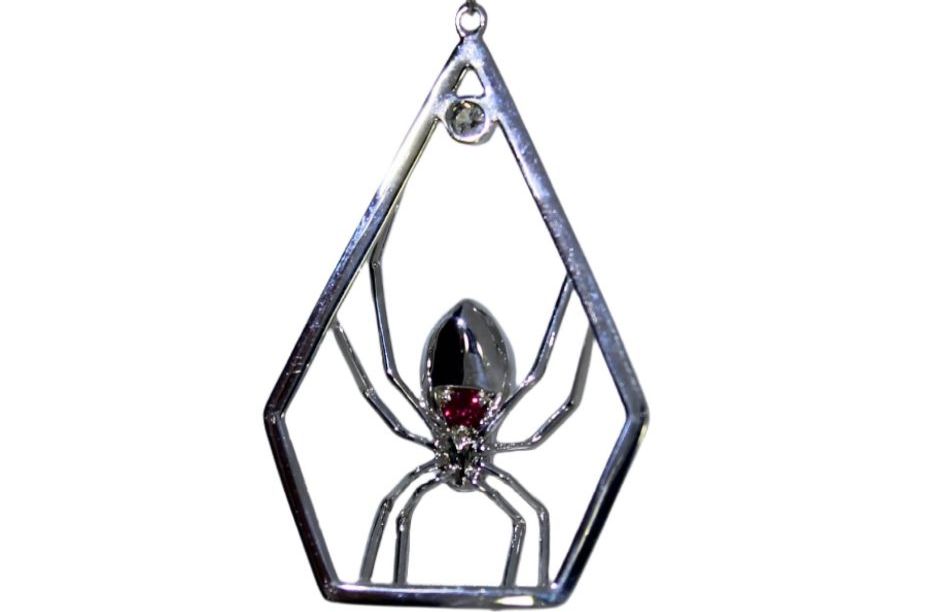
Jewelry has long been intertwined with cultural folklore and holiday traditions across various societies. During the holiday season, certain jewelry pieces not only serve as adornments but also carry deep symbolic meanings rooted in folklore. Protective Amulets in Various Cultures The concept of the evil eye is prevalent in many cultures, leading to the creation of protective amulets. In regions like the Caribbean, items such as blue beads or specific jewelry pieces are worn to ward off maljo, or the evil eye, especially during significant occasions like holidays when gatherings are common. Eastern European Traditions In Eastern European folklore, particularly in Ukraine, the legend of the Christmas Spider explains the origin of tinsel on Christmas trees. The tale speaks of a poor widow whose Christmas tree was decorated by spiders' webs, which turned to silver and gold in the morning sunlight. This story has inspired the tradition of spider-shaped ornaments and tinsel, symbolizing good fortune and the magic of the holiday season. Irish Folklore and Holiday Jewelry In Irish culture, symbols like the shamrock and the Claddagh hold significant meaning. The shamrock, for instance, is associated with St. Patrick, who, according to legend, used its three leaves to explain the Holy Trinity. This symbol is prevalent in Irish jewelry, especially during St. Patrick's Day, serving as a token of heritage and faith. Similarly, the Claddagh ring, featuring hands, a heart, and a crown, represents friendship, love, and loyalty. Exchanging such rings during the holidays is a tradition that reflects deep-rooted Irish values and stories. Modern Interpretations Contemporary jewelry designers often draw inspiration from these folkloric symbols, creating pieces that honor traditional stories while appealing to modern aesthetics. For instance, during the holiday season, there's a resurgence of interest in heirloom-inspired jewelry, such as vintage designs and repurposed items, reflecting a desire to connect with the past. Selecting Jewelry with Folkloric Significance When choosing jewelry as a holiday gift, considering the folklore and history associated with specific gemstones can add a layer of meaning and personalization. For instance, gifting a turquoise piece might convey wishes for protection and good fortune, while a garnet item could symbolize a desire for the recipient's happiness and health. Understanding these associations allows for more thoughtful and meaningful gift-giving during the holiday season. Incorporating the rich tapestry of gemstone folklore into holiday jewelry selections not only enhances the beauty of the gift but also imbues it with stories and meanings that can be cherished for generations. Come in and find a special gemstone to set or item that will surely bring a smile to your loved one. Sources Better Homes & Gardens The Irish Jewelry Company Wikipedia Wikipedia




